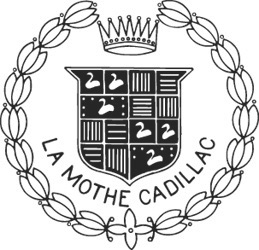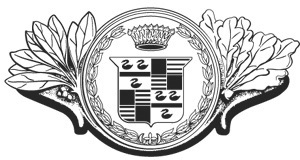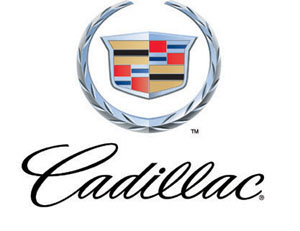Cadillac’s Crest

In a brochure celebrating the 25th anniversary of the Cadillac Motor Car Company, it is said that Antoine de la Mothe Cadillac, founder of Detroit (after whom the Cadillac automobile was named in 1902), possessed a pioneering, roving spirit. There was a description also of the Cadillac crest, said to have been designed four centuries before Columbus discovered America. It was asserted also that Cadillac was descended from the old counts of Toulouse, who in turn were affiliated with the Royal French stock. History tells a different story!
Most sources now agree that Cadillac borrowed the name and probably designed the crest himself, around the time he married, in 1687. Indeed part of the crest resembles closely the authentic coat of arms of an old neighbor of his, Baron Sylvester of Esparbes [or Esparbès] de Lussan, Lord of Lamothe-Bardigues.
The self-styled Lamothe-Cadillac was in fact of modest origins. He was born Antoine Laumet on March 5, 1658 at St. Nicolas-de-la-Grave, in France’s Tarn & Garonne Department. When he wed in 1687, not only did he knock four years off his age (stating it to be 26, instead of 30) but also he invented for himself a noble ancestry. He asserted that his (late) father was one Jean de Lamothe, sieur de Cadillac, Launay & Semontel, a Counselor to the Parliament in Toulouse. He identified his mother as a noblewoman by the name of Jeanne de Malenfant. However, his official birth certificate identifies his father as Jean Laumet, an assistant magistrate in the court at St. Nicolas-de-la-Grave. His mother was Jeanne Pechagut, a modest homemaker.
It was in 1682, at the age of 24, while allegedly serving in the military at Thionville that Laumet began calling himself Cadillac; it was customary in those days, for aspiring young officers to adopt a so-called “nom de guerre” (name of war); “Cadillac” had a good ring.

In 1683, Laumet set sail for the New World and in 1687, in Quebec (which was New France at that time), he married Marie-Thérèse Guyon, niece of French-Canadian privateer, François Guyon. They had met at the Governor’s ball at Quebec’s Château St. Louis, when she was just seventeen. He signed the marriage register as “Lamothe Launay” and named his mother as Jeanne de Malenfant. The French particle “de” implies noble birth. However, if taken separately, the French words “de mal enfant” literally mean “of the evil child”. Was Antoine attempting to be coy by admitting that, in fact, he was “Mommy’s bad boy”?
It was relatively common for adventurous Frenchmen emigrating to the New World in those days to usurp the noble title and armorial bearings of true, blue-blooded noblemen back home who – it was assumed – would never find out about it. Laumet was no exception; he borrowed the name Lamothe, possibly on account of its consonance with Laumet. He also took over the noble ancestry associated with the Lamothe name as well as the coat of arms of Baron Sylvester.
The late Harry Pulfer, who researched the Cadillac coat of arms in America, said that its origins were less known although he did assert that the armorial bearings of the Cadillac family had been “set down in French heraldry”. I assume he was referring to the records of Canada’s Drouin Institute of genealogy. In reality, however, there is no noble Cadillac family to which Antoine Laumet might be connected, nor any crest like the one used on Cadillac motor cars since 1906. The closest such crest is the one belonging to the real Lamothe family.

The Cadillac coat of arms is a believable montage of bits and pieces of authentic heraldry that Antoine Laumet put together to serve his own purpose. Even though it was duly and officially registered and recorded, circa 1687, by the heraldic authorities of Quebec in New France (now Canada), the only authentic parts of the Cadillac crest are the first and fourth quarterings featuring the legless birds; in heraldry these are known as martlets [merlettes in French]. They are the heraldic adaptation of the martin.
The crest that Laumet “borrowed” still graces the imposing wrought-iron gates of the Château de Bardigues, near Castelsarrasin; he merely changed the colors. He added in the 2nd and 3rd quarters the additional coat of arms of either Virès, in France’s Languedoc region, or Albret in Gascony [Source: Report on Canadian Archives, Ottawa, 1911].
The Cadillac family crest is recognized by Canada’s Institut généalogique Drouin [the Drouin Genealogical Institute] simply because that crest was duly recorded in Quebec by Laumet-Cadillac himself. As a result, that questionable crest is described also in Tome 1 of the 1951 Belgian Armorial Universel, on p.255 (the entry being cross-referenced “I.G.D.” = Institut généalogique Drouin).

There is no record in France of any Lamothe-Cadillac family or crest, other than the one “invented” by Antoine Laumet when he was in the New French Territories.
In 1999, Cadillac announced the first change in its shield-and-crest emblem since 1963. The new, cleaner design was used in company advertising, starting in 1999, and on Cadillac cars beginning in 2002. The crest remains but the crown over the shield is gone, as are also the merlettes…
In the words of writer-historian, Annick Hivert-Carthew, “Wrapped in a cloak of assumed identity and origins … Cadillac emerges victorious. He has accomplished what many of his detractors have not: a lasting masterpiece — the city of Detroit. He has achieved immortality.”
Cadillac’s emblem has undergone more than 30 revisions during the company’s 97-year history to reflect changes in culture and design direction.


You must be logged in to post a comment.